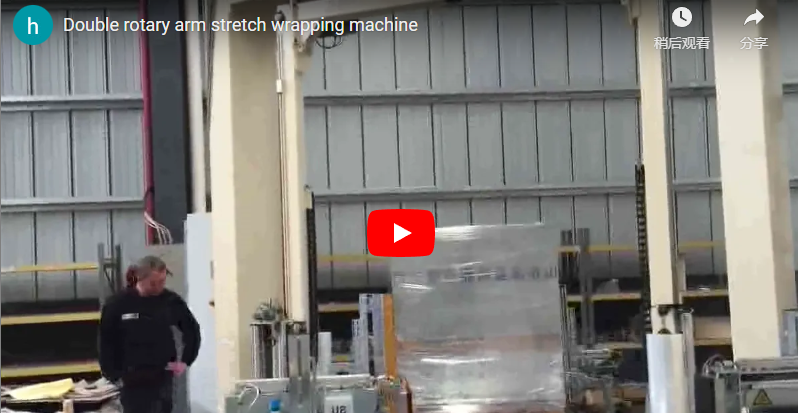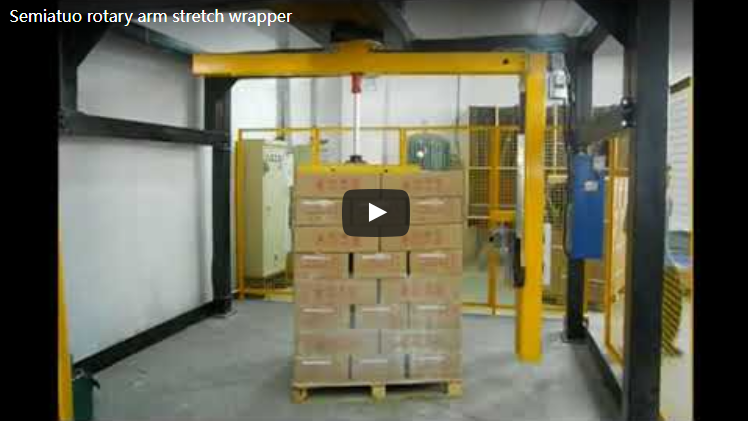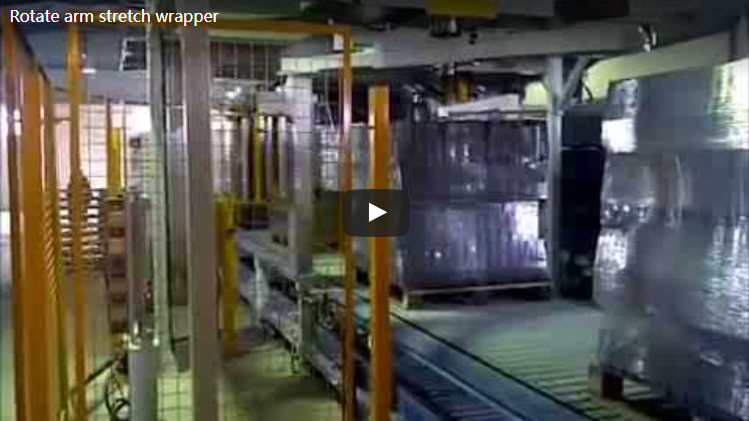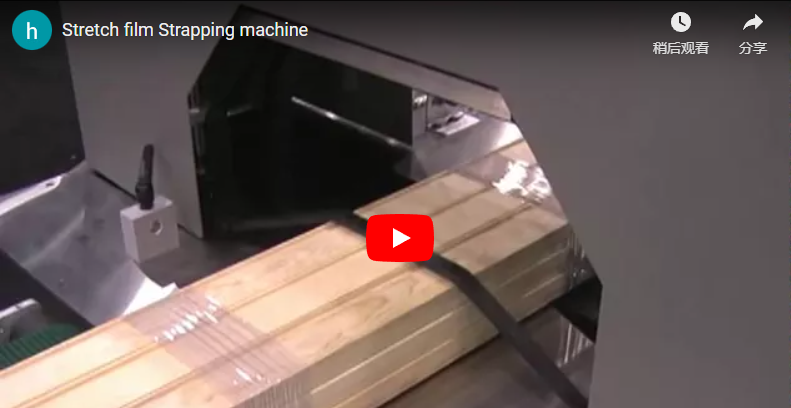Mastering Load Containment: A Deep Dive into Rotate Arm Stretch Wrappers
In modern manufacturing and distribution, ensuring pallet loads arrive intact is paramount. Damaged goods erode profits and customer trust. While various stretch wrapping technologies exist, the rotate arm stretch wrapper (often called a rotary arm stretch wrapper) stands out as a robust solution, particularly for challenging loads. This article dives into the mechanics, benefits, and practical considerations of these essential machines, offering insights valuable to fabricators and operations managers.
(Video: Example of a rotate arm stretch wrapper in action. Alt Text: Rotate arm stretch wrapper applying blue stretch film to a pallet load of boxes.)
1. Understanding the Mechanics: How Rotate Arm Wrappers Work
Unlike turntable stretch wrappers where the pallet load spins, a rotate arm wrapper keeps the load stationary. This is its defining characteristic and primary advantage for certain applications. Here’s the breakdown:
- Stationary Load: The pallet load is placed on the floor or a conveyor section within the machine's wrap zone. It does not move during the wrap cycle.
- Rotating Arm: An overhead arm, equipped with the film carriage system, rotates around the stationary pallet.
- Film Carriage: Mounted on the rotating arm, the film carriage dispenses the stretch film. It typically moves vertically on a mast attached to the arm to cover the entire height of the load.
- Film Application: As the arm rotates and the carriage moves vertically, layers of stretch film are applied, creating a secure, unitized load.
This design is fundamentally different from turntable models and is crucial for handling loads that are exceptionally heavy, tall, unstable, or have an irregular shape that could shift or topple if rotated at speed.
2. Core Advantages for Fabricators and High-Volume Operations
Choosing a rotate arm wrapper offers several operational benefits:
- Superior Load Stability During Wrapping: By keeping the load stationary, the risk of product shifting or damage due to centrifugal force is eliminated. This is ideal for light, easily disturbed loads or very heavy, potentially unbalanced loads common in metal fabrication or building materials.
- High Throughput Capability: These machines are often designed for demanding, high-volume environments. While speeds vary, many models can wrap upwards of 50-100+ loads per hour, integrating seamlessly into automated packaging lines.
- Unlimited Load Weight Capacity: Since the load sits directly on the floor or a heavy-duty conveyor, the machine itself doesn't bear the load's weight, unlike turntable models which have weight limits.
- Flexibility for Large or Awkward Profiles: The wrap zone can often accommodate larger length and width dimensions compared to standard turntable wrappers.
- Enhanced Safety Features: Typically enclosed within safety fencing with light curtains or scanners at entry/exit points, minimizing personnel interaction during the potentially hazardous wrap cycle.
3. Key Technical Specifications to Evaluate
When considering a rotate arm stretch wrapper, scrutinize these parameters:
- Maximum Load Size (L x W x H): Ensure the machine's wrap zone can accommodate your largest pallet profiles.
- Arm Rotation Speed (RPM): Impacts throughput (Loads Per Hour). Higher speeds mean faster wrapping.
- Film Carriage Vertical Speed: Determines how quickly the load height is covered.
- Film Pre-stretch Capability: This is critical for film economy and load containment. Look for powered pre-stretch systems offering 200-300% or more. This stretches the film before application, maximizing yield and improving holding force.
- Film Delivery System: Details like the type of rollers, film threading mechanism, and automatic film cut-and-clamp/wipe system affect reliability and ease of use.
- Control System: Typically PLC-based (Programmable Logic Controller) with an HMI (Human-Machine Interface) touch screen for setting wrap parameters (top/bottom wraps, tension, overlap, custom patterns).
- Power & Air Requirements: Ensure compatibility with your facility's utilities (e.g., 480V 3-Phase power, compressed air for certain functions).
- Construction & Durability: Look for heavy-gauge steel construction suitable for industrial environments.
4. From the Shop Floor: Operator Insights and Best Practices
Getting the most out of your rotate arm wrapper involves more than just hitting 'start'. Here's some practical wisdom:
- Proper Film Threading is Crucial: An incorrectly threaded film path is a primary cause of film breaks and poor pre-stretch performance. Ensure operators are thoroughly trained.
- Dialing in Parameters: Don't just 'set and forget'. Adjust film tension, overlap percentage, and top/bottom wrap counts based on the specific load characteristics. Too little tension leads to loose loads; too much can crush cartons.
- Routine Maintenance Pays Off:
- Keep photo-eyes and sensors clean for reliable operation.
- Regularly inspect film carriage rollers for wear or residue buildup.
- Check and lubricate the main arm bearing and drive components as per the manufacturer's schedule.
- Ensure the film cut-and-wipe mechanism is clean and sharp.
- Troubleshooting Basics: Understand common issues like film breaks (check for nicks in the roll, incorrect tension, obstructions) or incomplete wraps (check sensors, program settings).
5. Integrating Rotate Arm Wrappers into Your Workflow
Implementation requires planning:
- Footprint and Layout: These machines require significant floor space, including clearance for the rotating arm and safety guarding. Consider integration with existing or new conveyor systems for automated loading and unloading.
- Return on Investment (ROI): Calculate potential savings from:
- Reduced labor costs compared to manual or semi-automatic wrapping.
- Significant film cost savings through efficient pre-stretching.
- Minimized product damage during shipping due to improved load containment.
- Increased overall throughput.
6. Choosing the Right Machine: Key Questions for Vendors
Before purchasing, ask potential suppliers:
- Can you analyze our specific load types and throughput requirements?
- What customization options are available (e.g., integrated top sheet dispenser, roping device for enhanced stability, cold/hot environment packages)?
- What level of technical support, training, and spare parts availability do you offer?
- Can we see a machine running with loads similar to ours?
Conclusion: Secure Your Shipments with Advanced Wrapping Technology
The rotate arm stretch wrapper represents a significant investment, but for operations handling heavy, unstable, or high-volume pallet loads, it offers unmatched performance in load security and efficiency. By understanding its mechanics, leveraging its advantages, and implementing best practices, fabricators and logistics professionals can significantly reduce shipping damage, optimize film usage, and streamline their end-of-line packaging processes. These machines are workhorses designed for demanding environments, playing a critical role in ensuring products reach their destination safely and securely.
For further information or specific application queries:
https://www.fhopepack.com/Stretch_wrapping_machine.html
info@fhopepack.com






